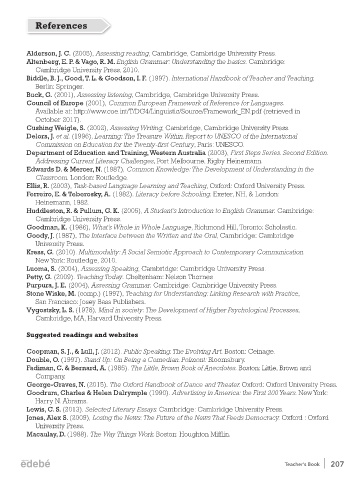Page 208 - @ccess 2 Teacher´s Book
P. 208
References
Alderson, J. C. (2005), Assessing reading, Cambridge, Cambridge University Press.
Altenberg, E. P. & Vago, R. M. English Grammar: Understanding the basics. Cambridge:
Cambridge University Press, 2010.
Biddle, B. J., Good, T. L. & Goodson, I. F. (1997). International Handbook of Teacher and Teaching.
Berlin: Springer.
Buck, G. (2001), Assessing listening, Cambridge, Cambridge University Press.
Council of Europe (2001), Common European Framework of Reference for Languages.
Available at: http://www.coe.int/T/DG4/Linguistic/Source/Framework_EN.pdf (retrieved in
October 2017).
Cushing Weigle, S. (2002), Assessing Writing, Cambridge, Cambridge University Press.
Delors, J. et al. (1996), Learning: The Treasure Within. Report to UNESCO of the International
Commission on Education for the Twenty-first Century, Paris: UNESCO.
Department of Education and Training, Western Australia (2003), First Steps Series. Second Edition.
Addressing Current Literacy Challenges, Port Melbourne, Rigby Heinemann.
Edwards D. & Mercer, N. (1987), Common Knowledge: The Development of Understanding in the
Classroom. London: Routledge.
Ellis, R. (2003), Task-based Language Learning and Teaching, Oxford: Oxford University Press.
Ferreiro, E. & Teberosky, A. (1982). Literacy before Schooling. Exeter, NH, & London:
Heinemann, 1982.
Huddleston, R. & Pullum, G. K. (2005), A Student’s Introduction to English Grammar. Cambridge:
Cambridge University Press.
Goodman, K. (1986), What’s Whole in Whole Language, Richmond Hill, Toronto: Scholastic.
Goody, J. (1987), The Interface between the Written and the Oral, Cambridge: Cambridge
University Press.
Kress, G. (2010). Multimodality: A Social Semiotic Approach to Contemporary Communication.
New York: Routledge, 2010.
Luoma, S. (2004), Assessing Speaking, Cambridge: Cambridge University Press.
Petty, G. (2009). Teaching Today. Cheltenham: Nelson Thornes
Purpura, J. E. (2004), Assessing Grammar. Cambridge: Cambridge University Press.
Stone Wiske, M. (comp.) (1997), Teaching for Understanding: Linking Research with Practice,
San Francisco: Josey Bass Publishers.
Vygostsky, L. S. (1978), Mind in society: The Development of Higher Psychological Processes,
Cambridge, MA, Harvard University Press.
Suggested readings and websites
Coopman, S. J., & Lull, J. (2012). Public Speaking. The Evolving Art. Boston: Ceinage.
Double, O. (1997). Stand Up: On Being a Comedian. Polmont: Bloomsbury.
Fadiman, C. & Bernard, A. (1985). The Little, Brown Book of Anecdotes. Boston: Little, Brown and
Company.
George-Graves, N. (2015). The Oxford Handbook of Dance and Theater. Oxford: Oxford University Press.
Goodrum, Charles & Helen Dalrymple (1990). Advertising in America: the First 200 Years. New York:
Harry N. Abrams.
Lewis, C. S. (2013). Selected Literary Essays. Cambridge: Cambridge University Press.
Jones, Alex S. (2009), Losing the News: The Future of the News That Feeds Democracy. Oxford : Oxford
University Press.
Macaulay, D. (1988). The Way Things Work. Boston: Houghton Mifflin.
Teacher’s Book 207

